Description
COLORADO MAHLERFEST XXXIV
COLORADO MAHLERFEST ORCHESTRA
KENNETH WOODS, CONDUCTOR
DISC I: Philip Sawyers: Symphony No. 5*
1. Moderato 11:50
2. Allegro 5:03
3. Lento 9:32
4. Presto 4:56
5. Allegro 8:27
DISC II: Gustav Mahler: Symphony No. 5
Part 1
1. Trauermarsch 12:23
2. Stürmisch bewegt, mit größter Vehemenz 14:33
Part 2
3. Scherzo 18:52
Part 3
4. Adagietto 9:06
5. Rondo-Finale 17:03
*World premiere
Recorded by Jonathan Galle
Editing and mastering by Tim Burton
RECORDED IN CONCERT AUGUST 28, 2021 | MACKY AUDITORIUM
BOULDER, COLORADO | © 2022 Colorado MahlerFest All Rights Reserved
Please note – for environmental reasons, this item is not shrink-wrapped.
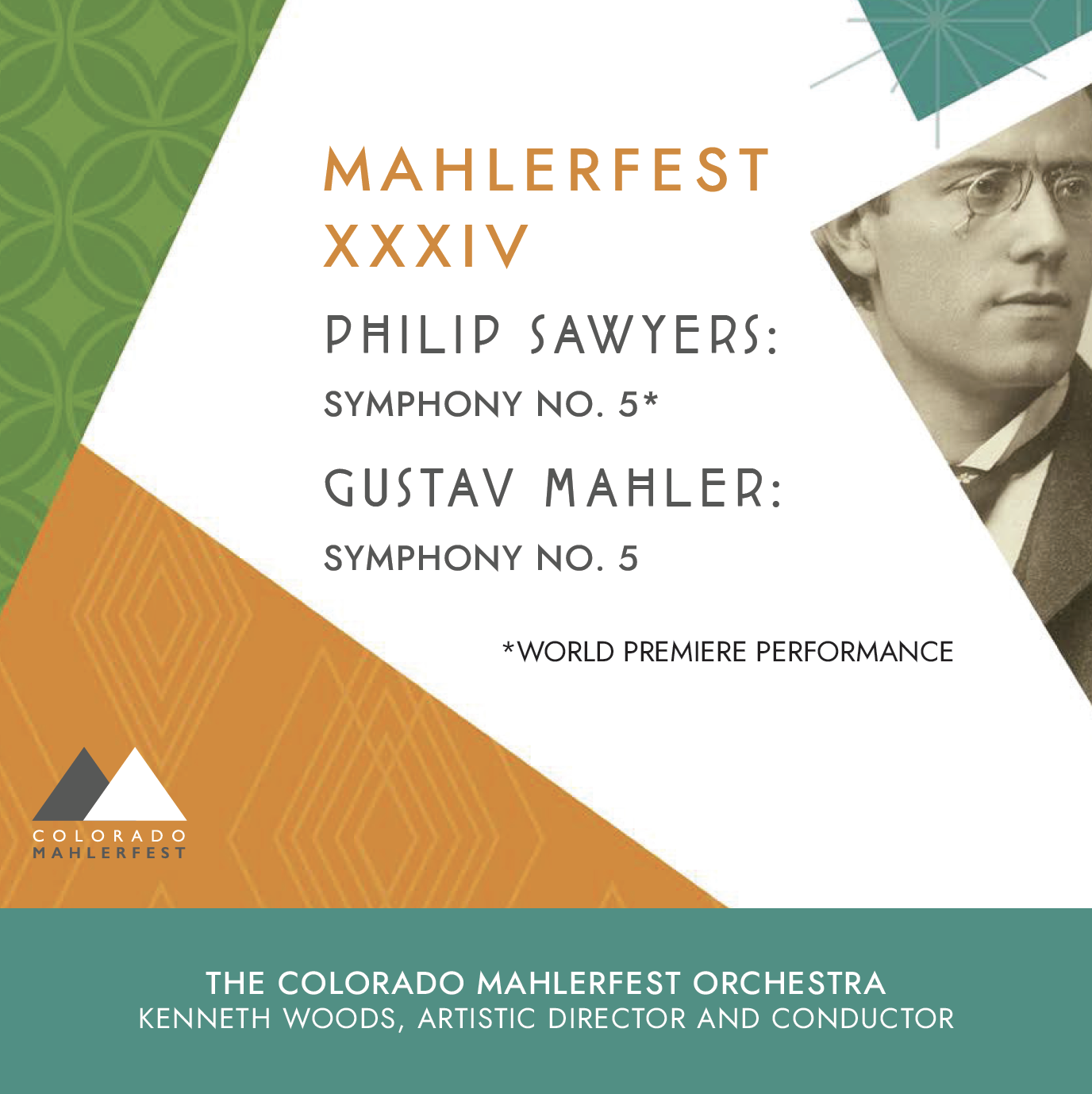
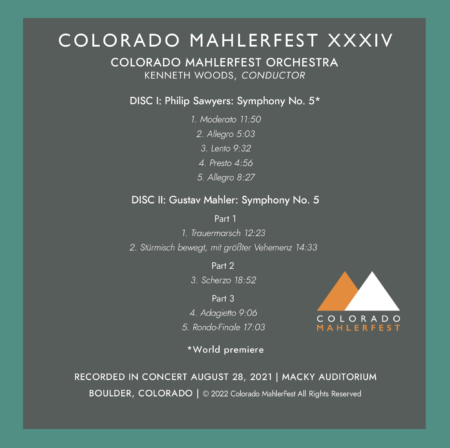
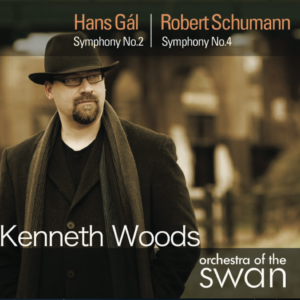
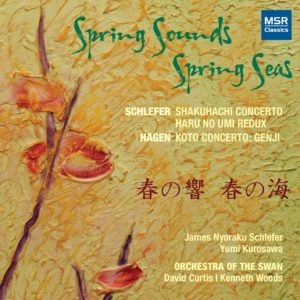
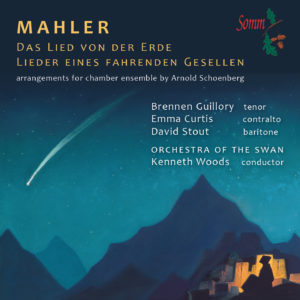
Admin –
“It should be added that the playing of the Colorado MahlerFest Orchestra was of a consistently high standard – testifying to the excellence of the individual musicians as, also, their collective responsiveness to Woods’s technical acumen and interpretative insight. Its latter-day status as mainstream repertoire may have obscured its innovative qualities (and drawn attention away from its unevenness), but to hear this work so authoritatively realized and within the context of a major new symphonic statement says much for the continued importance of MahlerFest.” Richard Whitehouse, Arcana.FM
https://arcana.fm/2021/12/15/colorado-mahler-sawyers/
Admin –
”Mahler famously said that the symphony “must be like the world” and the “embrace everything,” and that is almost true of just the first movement of the Fifth. It covers a dizzying array of musical topics, from ceremonial march to sentimental dance. It is this variety that makes Mahler’s symphonies such a challenge to a conductor, who has to maneuver an orchestra through all of Mahler’s minefields of shifting tempos and surging emotional fluctuations.
Woods handled this like the veteran Mahlerian he is. There was never a sense of tentativeness about tempo, any hesitation around entrances, or anything less than full commitment to the extremes of emotional expression. Especially impressive was the third movement Scherzo, a tour-de-force of high-paced peasant dances interrupted by a moment of pure schmaltz, and then a grotesque moment of pizzicato strings, each effective in its turn.” Peter Alexander, Sharps and Flatirons
https://sharpsandflatirons.com/2021/08/29/34th-mahlerfest-ends-with-splendid-festival-finale-concert/
Admin –
The reception for this premiere—really, as well-prepared and finely executed as any composer could wish for—was suitably enthusiastic. (It should be noted that the second half of this concert saw a performance another Fifth Symphony: Mahler’s! This orchestra does not lack stamina! Woods, by the way, is as fine a Mahler conductor as I have had the privilege to hear.) The winds shone in particular in the two scherzi, though had some telling solos elsewhere, such as that for the principal flute towards the close of the Lento. The brass were magisterial throughout the outer and central spans, but the bedrock on which Sawyers constructs his symphonic edifices was provided by the strings, who did not disappoint. I cannot wait for the UK premiere, and the chance to hear this terrific symphony, very possibly Sawyers’ finest, in the flesh.” Guy Rickards, Musical Opinion
https://mahlerfest.org/review-musical-opinion-on-mf-xxxiv/
Admin –
MusicWeb Internationa
https://www.musicwebinternational.com/2023/05/mahler-symphony-5-colorado-mahlerfest/
Gustav Mahler (1860-1911)
Symphony No 5 in C-sharp minor
Philip Sawyers (b.1951)
Symphony No 5 in B-flat minor
Colorado MahlerFest Orchestra/Kenneth Woods
rec. live, 28 August 2021, Macky Auditorium, Boulder, Colorado
Colorado MahlerFest [2 CDs: 118]
I was writing only last year on MusicWeb International of how I felt Colorado MahlerFest does not quite receive the international attention it deserves – and now this disc arrived to be reviewed. Certainly, the writings and interpretive thoughts of the festival’s current Music Director, Kenneth Woods, are hugely insightful and put many other leading conductors of this music practising today to shame, so it is a pleasure to be able to review this latest release of a live concert from two years ago at MahlerFest, not least because of its interesting coupling, another Fifth Symphony, this time the world premiere performance of Philip Sawyers’. Indeed only a few weeks ago, my MWI colleague, Nick Barnard, was very impressed by a recent release containing Sawyers’ music (review) and mused at the time how recordings of this composer’s Fifth and Sixth Symphonies have yet to be made, which this release now partially remedies. It forms part of Kenneth Woods’ stated aim with the festival that, like Mahler before him, a conductor’s job is to promote music that continues to build upon and expand the existing repertoire and, as such, much credit needs to be given for this endeavour.
So the first half of this concert from 2021 featured the Sawyers symphony, a work that is scored for full strings, harp, double woodwind, four horns, three trumpets, three trombones, tuba, as well as timpani and is cast over five movements, lasting around forty minutes. It was written in 2021 and this is its world premiere from August of that same year. In my interview with Kenneth Woods, he expressed the opinion that the London-born Sawyers was very much a composer of the German school and certainly this symphony’s opening is cloaked with the claustrophobic atmosphere of late Romanticism, of Schrecker and Zemlinsky, at times almost Bergian in its gloom, with a meandering melody on the strings underpinned by pizzicato basses, until muted horn fanfares, resignedly signal something perhaps more portentous. Indeed, the movement soon works itself up into stormy climaxes that are grim and ominous, until at the end the fanfares return, this time fortissimo, before the music seemingly burns itself out, with harp arpeggios and a final tap on the drum.
Sawyers has a very distinctive voice; as soon as you think you recognise a composer, such as the staccato writing for woodwind, or a particularly creepy violin run and identify it as Prokofiev, the music takes a different turn. This is particularly true of the second and fourth movements, both of which inhabit a sound-world that may initially appear frivolous but has darker shadows lurking within and frame the central middle movement, marked lento. This opens radiantly, recalling Vaughan Williams in full pastoral splendour (Sawyers’ only composition teacher, Helen Glatz, was a pupil of Vaughan Williams), until the clouds appear once more on the soundscape, swirling malevolently, before the movement ends serenely. The last movement begins with declamatory fanfares, but the mood is not one of resolution and the music is clearly struggling to find its triumphant end before, with Waltonian fanfares briefly ring out, the orchestra disappears into the mists of more Vaughan Williams magic and the symphony ends quietly.
As a performance of a world premiere, this is a remarkably assured account, played with much dedication and led with distinction from the podium by Kenneth Woods who clearly believes in this music. As a first half of a concert that precedes the Fifth Symphony of Mahler, no less, it is both different as well as more substantial than normal and, in my opinion, a score which repays multiple listens and is recommended to anyone curious to explore modern music that is at once both accessible, as well as stimulating.
There is a story, probably true, about a prestigious Berlin ensemble performing Mahler’s Fifth Symphony at New York’s Carnegie Hall under their recently installed Italian Music Director, in which the first trumpeter had an off-night from his opening solo onwards. No such problems befall the principal trumpeter of Colorado MahlerFest Orchestra, Daniel Kelly who, along with the rest of his colleagues in the brass section, is on terrific form. Indeed, after that demanding first half and for a one-off performance, the playing of the orchestra is remarkably assured and accurate, with just the occasional minor imprecisions that you would expect when playing live. Woods’ interpretation is, as always, full of insights and lasts just over seventy minutes, which is a few minutes faster than the late, live recordings of both Bernstein with the Vienna Philharmonic and Klaus Tennstedt with the London Philharmonic, as well as John Barbirolli with the New Philharmonia Orchestra, putting him closer to Rudolf Barshai’s famous account with the Junge Deutsche Philharmonie, with which it shares some similarities. In the first movement, Woods is keen to highlight and establish the funeral march rhythms right from the outset and if he is not inclined to batter the listener on the solar plexus as Georg Solti was wont to do, especially with his first recording with the Chicago Symphony, that is not necessarily a bad thing. In the live performance, Woods allowed barely a break between the final pizzicato that ends the opening movement (presented here as a thud, as if the snapping shut of a coffin lid) and the start of the second, something that is retained in the compact disc edition, but is less apparently obvious on the download. Not only does this respect the composer’s intention that the first two movements were to form a ‘Part 1’ with this symphony, but it also means the intensity built up in the opening movement is allowed to cascade into the following movement. In particular, amidst the storm and turmoil of this movement, when the clouds suddenly part and the listener gets a brief glimpse of the work’s final chorale, under Woods’ baton it is as if a rainbow has suddenly appeared in the storm and a vision of Valhalla can be seen through the clouds at its end, a point reinforced by Woods slight broadening of the pulse for this passage and his magnificent brass players reaching genuine Wagnerian heights.
In my interview with Kenneth Woods, he presented a significant argument that in Part 2 of this symphony, the central scherzo, Mahler was hugely influenced by Goethe’s poem An Schwager Kronos (‘To Brother Time the Coachman’), which tells of a young man living life too fast, a point not lost on the composer himself at that moment in his life, who almost broke down due to overwork. In this regard, Woods argues that the movement should be taken more slowly than the usual sparkling, waltz-like lilt and indeed, at a few seconds short of nineteen minutes, his is one of the slowest you will encounter on record, a minute slower than the ‘leisurely’ John Barbirolli and only a few seconds short of Bernstein on DG. Some of Woods’ tempos are indeed noticeably slower than usual, for example, at around the five-minute mark in the movement where the score is marked ‘langsammer’ (slower – bar 241) and he has to effect an unmarked decelerando so to avoid any clunky gear change at this point. That said, I would much rather this than any bland run-through – and this performance most certainly is not that.
In Part 3 of the symphony, the Adagietto starts slowly, Woods correctly observing the Sehr langsam (Very slow) indication on the first bar, but he does not stick rigidly to the marking, varying the tempos in the central section, smiling through the tears before allowing the movement to magically die away and the final movement to begin. This is both joyful and exciting, the players clearly relishing and rising to the challenge, until the final chorale is reached where its reprise is allowed to expand into the Wagnerian splendour first hinted at in the second movement. It caps a very distinguished interpretation and whilst I am sure that Colorado MusicFest will be the first to admit that they are neither the New York Philharmonic or Concertgebouw Orchestras, this mixture of experienced inspirational musicians alongside less experienced, aspirational ones, deliver a very fine performance indeed.
The physical CD just has listings of the pieces and musicians with a QR code that takes you to the full programme book (that is also available as part of the mp3 download), which is packed full of information on the performers, Mahler and the symphonies being performed. Overall, this is a fine entry into the canon of Mahler’s Fifth Symphony and with its unique coupling it is worth anyone’s time investigating.
Lee Denham
Availability: Bandcamp